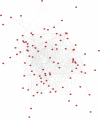Investigation of hub genes involved in diabetic nephropathy using biological informatics methods
- PMID: 33145306
- PMCID: PMC7575993
- DOI: 10.21037/atm-20-5647
Investigation of hub genes involved in diabetic nephropathy using biological informatics methods
Abstract
Background: The aim of this study was to find genes with significantly aberrant expression in diabetic nephropathy (DN) and determine their underlying mechanisms.
Methods: GSE30528 and GSE1009 were obtained by querying the Gene Expression Omnibus (GEO) database. The difference in target gene expression between normal renal tissues and kidney tissues in patients with DN was screened by using the GEO2R tool. Using the Database for Annotation, Visualization, and Integrated Discovery (DAVID) database, differentially expressed genes (DEGs) were analysed by Gene Ontology (GO) annotation and the Kyoto Encyclopedia of Genes and Genomes (KEGG) pathway enrichment. Then, the protein-protein interactions (PPIs) of DEGs were analyzed by Cytoscape with the Search Tool for the Retrieval of Interacting Genes/Proteins (STRING) database, and the hub genes in this PPI network were recognized by centrality analysis.
Results: There were 110 genes with significant expression differences between normal and DN tissues. The differences in gene expression involved many functions and expression pathways, such as the formation of the extracellular matrix and the construction of the extracellular domain. The correlation analysis and subgroup analysis of 14 hub genes and the clinical characteristics of DN showed that CTGF, ALB, PDPN, FLT1, IGF1, WT1, GJA1, IGFBP2, FGF9, BMP2, FGF1, BMP7, VEGFA, and TGFBR3 may be involved in the progression of DN.
Conclusions: We confirmed the differentially expressed hub genes and other genes which may be the novel biomarker and target candidates in DN.
Keywords: Diabetic nephropathy (DN); bioinformatics analysis; differentially expressed gene (DEG); hub genes; microarray analysis.
2020 Annals of Translational Medicine. All rights reserved.
Conflict of interest statement
Conflicts of Interest: All authors have completed the ICMJE uniform disclosure form (available at http://dx.doi.org/10.21037/atm-20-5647). The authors have no conflicts of interest to declare.
Figures





Similar articles
-
Investigation of the Mechanism of Complement System in Diabetic Nephropathy via Bioinformatics Analysis.J Diabetes Res. 2021 May 24;2021:5546199. doi: 10.1155/2021/5546199. eCollection 2021. J Diabetes Res. 2021. PMID: 34124269 Free PMC article.
-
Integrated Bioinformatics and Clinical Correlation Analysis of Key Genes, Pathways, and Potential Therapeutic Agents Related to Diabetic Nephropathy.Dis Markers. 2022 May 21;2022:9204201. doi: 10.1155/2022/9204201. eCollection 2022. Dis Markers. 2022. PMID: 35637650 Free PMC article.
-
Integrative analyses of biomarkers and pathways for diabetic nephropathy.Front Genet. 2023 Apr 11;14:1128136. doi: 10.3389/fgene.2023.1128136. eCollection 2023. Front Genet. 2023. PMID: 37113991 Free PMC article.
-
Network pharmacology-based identification of miRNA expression of Astragalus membranaceus in the treatment of diabetic nephropathy.Medicine (Baltimore). 2022 Feb 4;101(5):e28747. doi: 10.1097/MD.0000000000028747. Medicine (Baltimore). 2022. PMID: 35119030 Free PMC article.
-
Identifying C1QB, ITGAM, and ITGB2 as potential diagnostic candidate genes for diabetic nephropathy using bioinformatics analysis.PeerJ. 2023 May 25;11:e15437. doi: 10.7717/peerj.15437. eCollection 2023. PeerJ. 2023. PMID: 37250717 Free PMC article.
Cited by
-
Identification of hub genes associated with diabetic cardiomyopathy using integrated bioinformatics analysis.Sci Rep. 2024 Jul 3;14(1):15324. doi: 10.1038/s41598-024-65773-z. Sci Rep. 2024. PMID: 38961143 Free PMC article.
-
Landscape of infiltrating immune cells and related genes in diabetic kidney disease.Clin Exp Nephrol. 2024 Mar;28(3):181-191. doi: 10.1007/s10157-023-02422-1. Epub 2023 Oct 26. Clin Exp Nephrol. 2024. PMID: 37882850
-
Overexpression of TGFBR3 Aggravates Cognitive Impairment and Neuroinflammation by Promoting Microglia M1 Polarization in the APP/PS1 Mouse Model of Alzheimer's Disease.Mol Neurobiol. 2025 Jun;62(6):7706-7722. doi: 10.1007/s12035-025-04731-w. Epub 2025 Feb 10. Mol Neurobiol. 2025. PMID: 39930283
-
The Multiple Roles of Fibroblast Growth Factor in Diabetic Nephropathy.J Inflamm Res. 2021 Oct 14;14:5273-5290. doi: 10.2147/JIR.S334996. eCollection 2021. J Inflamm Res. 2021. PMID: 34703268 Free PMC article. Review.
-
AKT3 and related molecules as potential biomarkers responsible for cryptorchidism and cryptorchidism-induced azoospermia.Transl Pediatr. 2021 Jul;10(7):1805-1817. doi: 10.21037/tp-21-31. Transl Pediatr. 2021. PMID: 34430428 Free PMC article.
References
LinkOut - more resources
Full Text Sources
Miscellaneous
